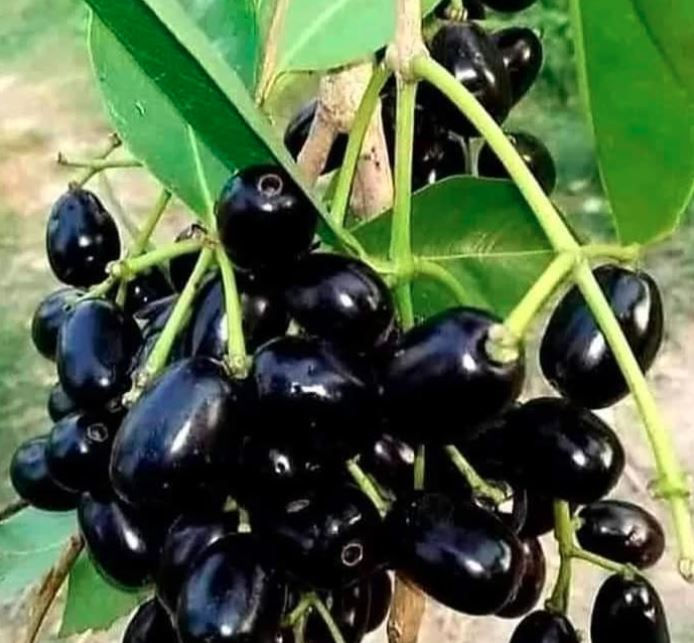Mzambarau (Syzygium cumini): Uses, Benefits, Fruits & Tree Guide
- BeyondForest

- Jun 23
- 5 min read
Updated: 16 hours ago

1.)About Mzambarau (Syzygium cumini)
3.)Characteristics of Syzygium cumini Tree
4.)Syzygium cumini Leaves
8.)Common Questions About Mzambarau (FAQ)

Mzambarau (Syzygium cumini) is a tropical evergreen fruit tree widely known across Africa and Asia for its delicious deep-purple fruits and powerful medicinal properties. In East Africa—especially Kenya, Tanzania, and Uganda—it is commonly called Mzambarau or Zambarau, while globally it is known as Jambolan, Jamun, Black Plum, or Java Plum. The tree belongs to the Myrtaceae family, the same family as eucalyptus and guava.

Mzambarau grows naturally in warm, humid regions and can reach 10–30 meters in height, forming a dense, evergreen canopy. The tree is highly regarded for its ability to adapt to different soils, withstand drought once established, and produce fruits annually. Its glossy green leaves, pale flowers, and juicy purple fruits make it both ornamental and economically valuable.

Traditional communities use its fruits, leaves, bark, and seeds to manage blood sugar, digestion, infections, and overall immunity.
The fruits are oval-shaped, deep purple to black when ripe, and contain a sweet-tart flavor that leaves a mild, pleasant astringency in the mouth. Beyond its taste, Mzambarau is famous for its anti-diabetic, antioxidant, and anti-inflammatory properties.
Mzambarau Common Names
In Digo language it is known as Mzambarau. In English language it is known as Jambolan, Java plum. In Giriama language it is known as Mzambarau, Zambarau. In Luo Language it is known as Jamna. In SwahiIi language it is known as Mzambarau. In Teso language it is known as Erne.In Kalenjin it is known as Lamaiywet
Characteristics of Syzygium cumini Tree
The Syzygium cumini tree is an evergreen species known for its dense, wide canopy and impressive height, reaching 10–30 meters when fully mature. It typically develops multiple trunks, branching close to the ground, with the lower bark appearing rough, fissured, and dark, while the upper sections are smoother and greyish.

The leaves are glossy, leathery, and oval-shaped with a strong aromatic scent when crushed. Young shoots often show a pinkish or reddish tint before turning deep green. The tree produces small, creamy-white flowers in clusters, followed by purple-black fruits. Its strong root system allows it to thrive in riverbanks, withstand flooding, and remain drought-resistant once established.
The fruit of Syzygium cumini (Mzambarau) is a small, oval, deep-purple to almost black berry when ripe, known for its juicy, sweet-tart flavor and mild astringency. The flesh is soft, refreshing, and rich in vitamin C, antioxidants, and anthocyanins, which give it its vibrant color. Each fruit contains a single seed. Mzambarau fruits are eaten fresh, used in juices, jams, and fermented drinks, and valued in traditional medicine for supporting digestion, immunity, and blood sugar balance.
The leaves of Syzygium cumini are glossy, leathery, and oval-shaped, typically measuring 6–15 cm long. They have a smooth texture with a pointed tip and a noticeable midrib running through the center. When crushed, the leaves release a distinctive aromatic, spicy scent, a characteristic common within the Myrtaceae family. Young leaves often appear light pink or reddish before maturing into a deep, shiny green.
Syzygium cumini leaves contain high levels of tannins, flavonoids, and essential oils, giving them strong antimicrobial, anti-inflammatory, and antioxidant properties. Traditionally, leaf extracts and teas are used to support digestion, reduce inflammation, manage blood sugar, and boost immunity.

The bark of Syzygium cumini varies in texture and color as the tree matures. The lower trunk has rough, cracked, and dark grey bark, while the upper sections become smoother and pale grey. Rich in tannins and astringent compounds, the bark has long been used in traditional medicine. A decoction made from it is known for its antimicrobial, anti-inflammatory, and tissue-toning properties, especially for oral and digestive health.
Image of a 9” thick Jambolan Plum by Goebel Furniture
Health Benefits of Mzambarau (Fruit, Leaves & Bark)

Hand holding a clear container of glossy, ripe black and dark red jamun fruits by Ross Creek Tropicals
The fruits are rich in vitamin C, antioxidants, and anthocyanins, which help strengthen immunity, support heart health, and improve digestion. They also have mild astringent properties that help manage diarrhoea and boost gut health. The leaves contain powerful anti-inflammatory and antimicrobial compounds, making them effective for treating mouth ulcers, skin irritations, and minor infections. The bark, rich in tannins, is traditionally used to make a decoction for oral care, diarrhoea, sore throats, and blood sugar support. Combined, these parts promote overall wellness.
Medicinal Uses of Syzygium cumini
Syzygium cumini has been used in traditional medicine for centuries due to its powerful healing properties found in the fruits, leaves, bark, and seeds. The seeds are especially valued for supporting healthy blood sugar regulation, making them widely used in Ayurvedic remedies for diabetes management.
Leaf extracts are known for their anti-inflammatory, antimicrobial, and antioxidant effects, often used to treat infections, mouth ulcers, and digestive issues. The bark, rich in tannins, is boiled into a decoction for diarrhoea, sore throats, and oral care. The fruits, high in vitamin C and anthocyanins, help boost immunity, improve digestion, cleanse the liver, and support heart health.
What is Mzambarau?
Mzambarau, also known as Jambolan or Jamun, is a tropical fruit tree scientifically called Syzygium cumini. It produces deep-purple fruits with strong medicinal and nutritional value.
Where does Mzambarau grow?
It grows widely in Kenya, Tanzania, Uganda, India, and Southeast Asia. The tree thrives in warm climates with good rainfall and well-drained soils.
Image of Jambolan Seedling by Ross Creek Tropicals
Mzambarau fruits, leaves, and bark offer antioxidant, anti-inflammatory, and anti-diabetic properties. They support digestion, immunity, and blood sugar management.
Can you eat Mzambarau fruits raw?
Yes. The fruits are commonly eaten fresh. They have a sweet-tart flavor and leave a mild astringent aftertaste.
Are Mzambarau seeds medicinal?
Yes. The seeds are used in Ayurvedic medicine for healthy blood sugar control and improving liver function.
It is a fast-growing species, reaching maturity in around 40 years and capable of growing up to 30 meters tall.
Is Mzambarau drought-resistant?
Once established, the tree tolerates drought well but performs best in regions with heavy rainfall.
What are the uses of Mzambarau wood?
The wood is strong, water-resistant, and suitable for furniture, tool handles, poles, and construction work.
Can Mzambarau grow in sandy soils?
Yes. It grows well in sandy or loamy soils as long as drainage is good.
Yes. In many East African communities, the tree is valued for shade, fruit, traditional medicine, and homestead planting.














Comments